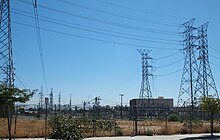Pacific DC Intertie
The Pacific DC Intertie , also known as Path 65 , is a high-voltage direct current transmission line (HVDC) in the western United States which is used to transport electrical energy from the north of the United States to the greater Los Angeles area. The line begins in the north of the state of Oregon at the Celilo converter station near the Columbia River and ends after 1362 km in southern California in the town of Sylmar near Los Angeles. It is operated by the Bonneville Power Administration and the Los Angeles Department of Water and Power (LADWP). The transmission capacity of the HVDC is a maximum of 3100 MW , which in 2006 corresponded to approx. ⅔ of the electricity requirements of the Los Angeles area.
construction
The HVDCT consists of two conductors and can be operated monopolar with +500 kV and the grounding as the return conductor, as well as bipolar with ± 500 kV with a maximum output of 2000 MW. In monopolar operation with the use of the earth electrode, the output per conductor is 1550 MW or 1000 MW if both conductors are used without an earth electrode. The current per conductor, using bundled conductors with two conductor cables each, is a maximum of 3.1 kA .
In monopolar operation at maximum power, a large current flows through the earth electrode. The earthing system in Celilo is located 10 km from the converter station in the form of a metallic iron ring with a diameter of 3255 m in the ground. To avoid electrolysis , which would destroy the metallic grounding electrode, the metallic conductor is embedded in petroleum coke, which establishes electrical contact with the surrounding soil. The earth resistance is 0.43 Ω. The grounding system in the south is located 48 km from the converter station in the Pacific Ocean and has a grounding resistance of 1.13 Ω.
The southern HVDC converter station Sylmar went into operation in 1970 and was originally equipped with mercury vapor rectifiers . In 1972, most of the converter station in Sylmar had to be rebuilt after an earthquake. In 1985 and 1989, the output was increased to 3100 MW with additional thyristors . In 2005 all mercury vapor rectifiers and the old thyristors were replaced by a new twelve-pulse rectifier with thyristors.
The manufacturers of the converter stations are the Swedish company Allmänna Svenska Elektriska Aktiebolaget (ASEA), now Asea Brown Boveri (ABB), and General Electric .
In addition to the HVDC Pacific DC Intertie, there is also the HVDC Intermountain ( Path 26 ) between Utah and Adelanto in California in the west of the USA .
Individual evidence
- ↑ THE PACIFIC INTERTIE SCHEME ( Memento from April 26, 2005 in the Internet Archive ), Technical Data of the Pacific DC Intertie, (English)
- ↑ Heat Wave Caught DWP Unprepared , LA Times online, September 10, 2006 (Eng.)
- ↑ Sylmar Converter Station Modernization Project ( Memento from December 14, 2011 in the Internet Archive ) (Eng.)
Web links
- Technical structure of the Pacific DC Intertie converter stations ( Memento from April 26, 2005 in the Internet Archive ), (English)


